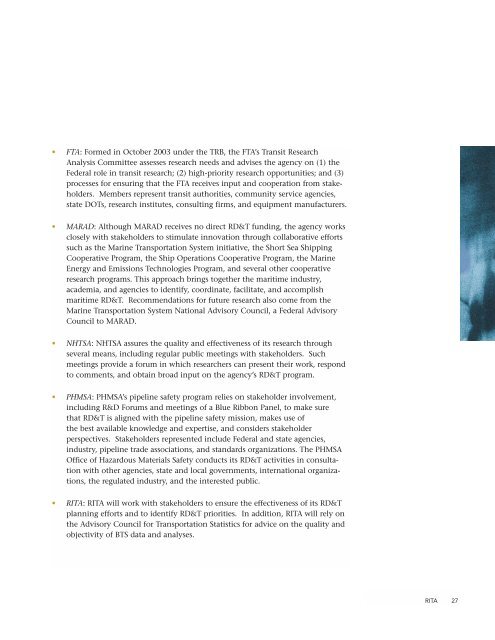Research Activities of the Department of Transportation: A Report to ...
Research Activities of the Department of Transportation: A Report to ...
Research Activities of the Department of Transportation: A Report to ...
You also want an ePaper? Increase the reach of your titles
YUMPU automatically turns print PDFs into web optimized ePapers that Google loves.
• FTA: Formed in Oc<strong>to</strong>ber 2003 under <strong>the</strong> TRB, <strong>the</strong> FTA’s Transit <strong>Research</strong>Analysis Committee assesses research needs and advises <strong>the</strong> agency on (1) <strong>the</strong>Federal role in transit research; (2) high-priority research opportunities; and (3)processes for ensuring that <strong>the</strong> FTA receives input and cooperation from stakeholders.Members represent transit authorities, community service agencies,state DOTs, research institutes, consulting firms, and equipment manufacturers.• MARAD: Although MARAD receives no direct RD&T funding, <strong>the</strong> agency worksclosely with stakeholders <strong>to</strong> stimulate innovation through collaborative effortssuch as <strong>the</strong> Marine <strong>Transportation</strong> System initiative, <strong>the</strong> Short Sea ShippingCooperative Program, <strong>the</strong> Ship Operations Cooperative Program, <strong>the</strong> MarineEnergy and Emissions Technologies Program, and several o<strong>the</strong>r cooperativeresearch programs. This approach brings <strong>to</strong>ge<strong>the</strong>r <strong>the</strong> maritime industry,academia, and agencies <strong>to</strong> identify, coordinate, facilitate, and accomplishmaritime RD&T. Recommendations for future research also come from <strong>the</strong>Marine <strong>Transportation</strong> System National Advisory Council, a Federal AdvisoryCouncil <strong>to</strong> MARAD.• NHTSA: NHTSA assures <strong>the</strong> quality and effectiveness <strong>of</strong> its research throughseveral means, including regular public meetings with stakeholders. Suchmeetings provide a forum in which researchers can present <strong>the</strong>ir work, respond<strong>to</strong> comments, and obtain broad input on <strong>the</strong> agency’s RD&T program.• PHMSA: PHMSA’s pipeline safety program relies on stakeholder involvement,including R&D Forums and meetings <strong>of</strong> a Blue Ribbon Panel, <strong>to</strong> make surethat RD&T is aligned with <strong>the</strong> pipeline safety mission, makes use <strong>of</strong><strong>the</strong> best available knowledge and expertise, and considers stakeholderperspectives. Stakeholders represented include Federal and state agencies,industry, pipeline trade associations, and standards organizations. The PHMSAOffice <strong>of</strong> Hazardous Materials Safety conducts its RD&T activities in consultationwith o<strong>the</strong>r agencies, state and local governments, international organizations,<strong>the</strong> regulated industry, and <strong>the</strong> interested public.• RITA: RITA will work with stakeholders <strong>to</strong> ensure <strong>the</strong> effectiveness <strong>of</strong> its RD&Tplanning efforts and <strong>to</strong> identify RD&T priorities. In addition, RITA will rely on<strong>the</strong> Advisory Council for <strong>Transportation</strong> Statistics for advice on <strong>the</strong> quality andobjectivity <strong>of</strong> BTS data and analyses.RITA 27
















